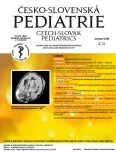Specific aspects of posttraumatic stress disorder in childhood and adolescence
Authors:
J. Kocourková; J. Koutek
Authors‘ workplace:
Dětská psychiatrická klinika 2. LF UK a FN Motol, Praha
Published in:
Čes-slov Pediat 2019; 74 (4): 216-219.
Category:
Overview
Posttraumatic stress disorder is a risk for children and adolescents exposed to a serious traumatic event. Both diagnostics and treatment, especially in younger children, are complicated due to the child’s immaturity in emotional, cognitive and relationship area. Recently, we differentiate between posttraumatic stress disorder as a result of one sudden unexpected endangering situation, and a complex posttraumatic stress disorder, which is a result of a repeated, long-term traumatization usually in an important interpersonal context.
The authors describe types of child trauma as well as characteristics of its clinical consequences and possibilities for treatment.
Keywords:
posttraumatic stress disorder – complex posttraumatic stres disorder – children and adolescents – therapy
Sources
1. Cohen JA, Scheeringa MS. Post-traumatic stress disorder diagnosis in children: challenges and promises. Dialogues Clin Neurosci 2009; 11 (1): 91–99.
2. Blank M. Posttraumatic stress disorder in infants, toddlers, and preschoolers. BCMJ 2007; 49 (3): 133–138.
3. Malá E. Posttraumatická stresová porucha u dětí a adolescentů. Lékařské listy 2011; 60 (9): 16–21.
4. Damien SI, Knieling A, Ioan BG. Post-traumatic stress disorder in children. Overview and case study. Rom J Leg Med 2011; 19: 135–140.
5. Kaplan S. Children in genocide. Int J Psychoanal 2006; 87: 725–746.
6. Terr L. Childhood traumas: An outline and overview. Am J Psychiatry 1991; 148 (1): 10–20.
7. Herman JL. Complex PTSD: a syndrome in survivors of prolonged and repeated trauma. J Trauma Stress 1992; 5: 377–391.
8.Mezinárodní klasifikace nemocí 10. revize. Praha: Psychiatrické centrum, 1992.
9.Diagnostický a statistický manuál duševních poruch DSM 5. Praha: Portál, 2015.
10. Haravuori H, Marttunen M. Something old, something new: disorders specifically associated with stress inthe ICS 11th revision. Psychiatria Fennica 2016; 47: 9–16.
11. Perry BD, Azad I. Posttraumatic stress disorders in children and adolescents. Curr Opin Pediatr 1999; 11: 310–316.
12. Cook A, et al. Complex trauma in children and adolescents. Psychiatr Ann 2005; 35 (5): 390–398.
13. Matheson C. A new diagnosis of complex Post-traumatic stress disorder, PTSD – a window of opportunity for the treatment of patiens in the NHS? Psychoanalytic Psychotherapy 2016; 30 (4): 329–344.
14. Giourou,E, Skokou M, Andrew SP, et al. Complex posttraumatic stress disorder: The need to consolidate a distinct clinical syndrome or to reevaluate feature sof psychiatric disorders following interpersonal trauma? World J Psychiatry 2018; 8 (1): 12–19.
15. Courtois CHA. Complex trauma, complex reactions : assessment and treatment. Psychotherapy: Theory, Research, Practice, Training 2004; 41 (4): 412–425.
16. Cloitre M., Stolbach BC, Herman JL, et al. A developmental approach to complex PTSD: Childhood and adult cumulative trauma as predictors of symptom complexity. J Trauma Stress 2009; 22 (5): 399–408.
17.Van der Kolk BA. Developmental trauma disorder. Psychiatr Ann 2005; 35 (5): 401–408.
18.Kocourková J, Koutek J. Posttraumatická stresová porucha u dětí a dospívajících. Čes a slov Psychiatr 2017; 113 (3): 128–131.
19.Practice parameter for the assessment and treatment of children and adolescents with posttraumatic stress disorder. J Am Acad Child Adolesc Psychiatry 2010; 49 (4): 414–430.
20.Guidelines for the assessment and treatment of children and adolescents with dissociative symptoms and dissociative disorders. Child and Adolescent Committee of the European Society for Trauma and Dissociation (ESTD), 2015.
Labels
Neonatology Paediatrics General practitioner for children and adolescentsArticle was published in
Czech-Slovak Pediatrics

2019 Issue 4
Most read in this issue
- Specific aspects of posttraumatic stress disorder in childhood and adolescence
- Psychiatric disorders with predominance of somatic symptoms in childhood and adolescence
- Possibilities of pharmacotherapy of depressive disorder in children and adolescents
- The role of maternal autoantibodies in the pathogenesis of autism spectrum disorders
